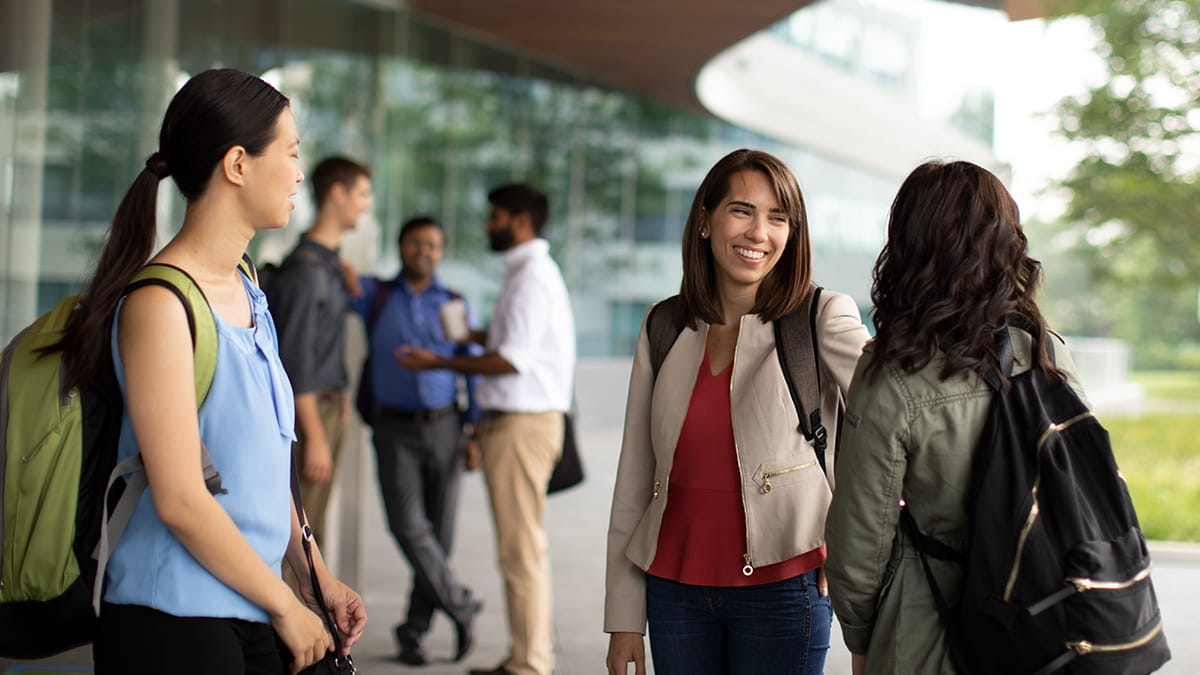How First-Year MBAs Chose Kellogg Over Other Schools

In a recent Poets & Quants article, Hereford Johnson (2Y 2022), Christianne Johnson (2Y 2022), Raman Malik (MMM 2022), Mashiwat Mahbub (2Y 2022), Mike Wise (2Y 2022) and Alyssa Posklensky (1Y 2021) were asked, “How did you determine your fit at various schools?” Here’s what they had to say.
Alumni network & pay-it-forward culture
Hereford Johnson: I first tried to determine the likelihood it would be to achieve my specific post-MBA target industry and geography. If I did not come across alumni presence in a target industry or geography, it did not make sense, I conducted coffee chats with employees in the industry to get an understanding on their preferred schools. If a school did not align at all, I removed it from my long list.
The next most important characteristic for me was a deeply-rooted pay-it-forward culture not just within the student body, but within the alumni network. I wanted it to be so engrained that I could feel comfortable cold calling an alumnus from 1992, and she would be excited to help me for simply being a part of the Kellogg community.
Paying it forward to the next generation is an important part of who I am, and I wanted to be a part of a community that genuinely celebrated and embraced that. I found that to be abundantly clear at schools like Kellogg. I feel that you really cannot determine this type of fit by just listening in on informational sessions or reading online forums. It really takes being proactive in doing coffee chats, picking up the phone, and doing school visits.
Belonging & Kellogg’s campus
Christianne Johnson: I visited Kellogg’s campus twice before deciding to join the class of 2022. The first time was for Diversity Preview Days when I was able to connect with current students and alumni. Later on, I came to Admitted Students Weekend, when I got a snapshot of who my actual classmates would be. During both of my visits, I really felt at ease and at home. I’d start chatting with someone and learning more about their Kellogg experience and would totally lose track of the time!
The campus was a huge selling point as well. I wasn’t familiar with Chicago and Evanston, but I was blown away by the Kellogg campus with and the Global Hub, which sits on Lake Michigan. The building is open and modern but with lots of convivial spaces. You can see downtown Chicago from the Hub but you have the benefit of tons of green space (I love to run) on the Northwestern campus.
Kellogg culture & academics
Raman Malik: I prioritized schools that would challenge me academically, feature a world-class technology and entrepreneurship curriculum, and offer a tight-knit culture. To better understand this, I reached out to as many alumni and current students as I could and attended local information sessions. I encourage others to do the same – it’s difficult to get a sense of culture without talking to a large sample of students and alumni from each school. Eventually, certain trends will emerge that will help you determine your fit.
Mashiwat Mahbub: The process of interviewing with Kellogg staff, chatting with Kellogg faculty and meeting the students helped me realize how Kellogg’s culture was the perfect fit for me. This was a determining factor for me. I wanted to be in a place where I was surrounded by worldly perspectives and backgrounds, as well as inclusive peers that would help me be my best self.
From a career perspective, I wanted to be in a school that had a growing rate of technology placements post-MBA.
Mike Wise: The main factors for me were the quality of academics and faculty, the culture, and the location. To evaluate the former and understand the experience at a high-level, I attended school info sessions, reviewed sites such as Poets&Quants, and looked at potential courses of interest for each school. For example, I sat in on a strategy case discussion at Kellogg’s Global Hub last fall and reached out to several Kellogg Innovation and Entrepreneurship (KIEI) faculty members for coffee chats; these discussions were invaluable in understanding the path I could take at Kellogg and demonstrated the engagement of the faculty. To better understand culture, I also spoke with several current or former students about their respective experiences.
Alyssa Posklensky: As I was applying, I looked for a passionate culture of involvement, a welcoming environment, and a strong Marketing focus. The Marketing piece was the easiest to find – all it took was a look at some rankings and class listings. However, the culture was the most important piece for me. To determine fit, I tried to both visit campus and to talk to current students.
I wanted to make sure that students were smart and passionate about their interests, yet humble. To find these students, it was as simple as reaching out to club leaders and admissions offices. You can learn so much from how students speak about their experience –much more than you’d ever learn on a website or in an information booklet. Sometimes, these conversations led to understanding that a program wasn’t the right fit – and that’s okay!
